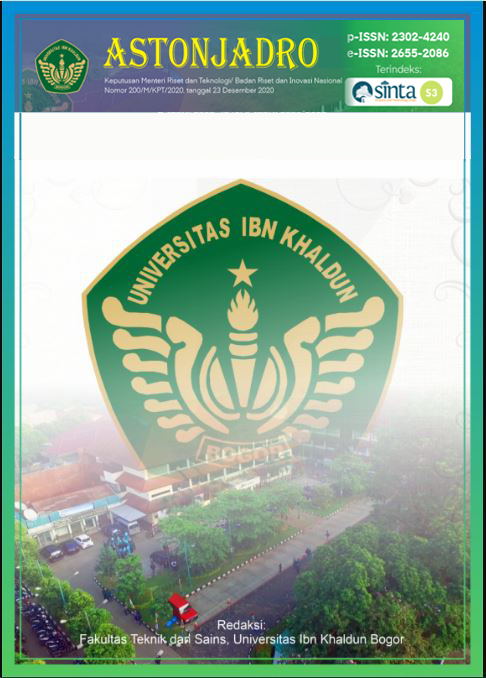Performance of Park as Public Space on the Needs, Availability, and Affordability of Services in Salatiga City (Study: Pancasila Park, Tingkir Park, Bendosari Park, and Sidomukti Park)
DOI:
https://doi.org/10.32832/astonjadro.v12i1.8547Keywords:
public space, park, needs, affordability, services, GIS.Abstract
Park as a public space is widely recognized in the global agenda to meet the targets of sustainable development goals in SDGs 3 and SDGs 11 to make cities and settlements healthy, inclusive, resilient and sustainable through the provision of Green Open Space (GOS). The commitment of Indonesian Government related to GOS is stated in the laws, the standard states that GOS in urban areas is 30% of the total area in which 12.5% is contained as a park in every settlement scale. Currently, Salatiga City has 4 parks with an average area of below 24,000 m2 and there are several residence and settlement-scale parks with an area below 250 m2. The purpose of this study is to determine park quantity against the needs, availability, and affordability. This study used a Geographic Information System (GIS) approach with a network analysist. Data collection method used questionnaire, observation and document review. The study showed (1) Based on the comparison between the existing needs and conditions of parks from 23 sub-districts, there were 9 sub-districts that had not met it 2) Based on the network analysis, the service affordability of 4 parks was only 57.53% of the urban area that had been served by parks, most of the areas in Argomulyo District had not been served. This study is a new study on park performance assessment with spatial analysis so future park development prioritizes areas that have a value gap between existing needs and conditions and have not been afforded by park service areas. The results of this study can be taken into consideration in the future development of park with a comprehensive analysis and database.
References
Byrne, J., & Sipe, N. (2010). Green and open space planning for urban consolidation--A review of the literature and best practice. In Issues Paper (Vol. 11, Issue May 2014).
Carr, S., Francis, M., Rivlin, L. G., & Stone, A. M. (1992). Public Space. Cambridge, UK: Cambridge University Press.
Harnik, P., & Simms, J. (2004). Parks: How far is too far. American Planning Association, 70(December), 1–8. www.planning.org/planning/member/2004dec/parks.htm?project
Kasperidus, H., Å uklje-Erjavec, I., & Costa, C. S. (2008). Strategy Development Guide. August.
Macintyre, S., Macdonald, L., & Ellaway, A. (2008). Lack of agreement between measured and self-reported distance from public green parks in Glasgow, Scotland. International Journal of Behavioral Nutrition and Physical Activity, 5(February). https://doi.org/10.1186/1479-Received
Micek, M., & Staszewska, S. (2019). Urban and rural public spaces: Development issues and qualitative assessment. Bulletin of Geography. Socio-Economic Series, 45(45), 75–93. https://doi.org/10.2478/bog-2019-0025
Miilunpalo, S. (2001). Evidence and theory based promotion of health-enhancing physical activity. Public Health Nutrition, 4(2b), 725–728. https://doi.org/10.1079/phn2001163
Neuvonen, M., Sievänen, T., Tönnes, S., & Koskela, T. (2007). Access to green areas and the frequency of visits - A case study in Helsinki. Urban Forestry and Urban Greening, 6(4), 235–247. https://doi.org/10.1016/j.ufug.2007.05.003
Nicholls, S. (2001). Measuring the accessibility and equity of public parks: a case study using GIS. 219, 201–219.
Peraturan Menteri Pekerjaan Umum Nomor 05/PRT/M/2008 tentang Pedoman Penyediaan dan
Pemanfaatan Ruang Terbuka Hijau di Kawasan Perkotaan
Purnomo, D., Sunaryanto, L. T., Priyanto, S. H., Rauta, U., Ismanto, B., & Herwandito, S. (2015). Kajian Pemekaran Kota Salatiga Tahun Anggaran 2015. 1–104.
Rahmawan, S. (2019). Perkembangan Permukiman Dan Pengaruhnya Terhadap Daya Dukung Lahan Kota Salatiga. Jurusan Geografi Universitas Negeri Semarang, 1–80.
Sarosa, W. (2020). Kota Untuk Semua Hunia yang Selaras dengan Sustainable Development Goals dan New Urban Agenda.
Smoyer-Tomic, K. E., Hewko, J. N., & Hodgson, M. J. (2004). Spatial accessibility and equity of playgrounds in Edmonton, Canada. Canadian Geographer, 48(3), 287–302. https://doi.org/10.1111/j.0008-3658.2004.00061.x
UN-Habitat. (2020). Public space site-specific assessment Guidelines to achieve quality public spaces at neighbourhood level. 88.
Downloads
Published
How to Cite
Issue
Section
License
Copyright (c) 2022 ASTONJADRO

This work is licensed under a Creative Commons Attribution-ShareAlike 4.0 International License.
Paper submitted to ASTONJADRO is the sole property of the Astonjadro Journal. Unless the author withdraws the paper because he does not want to be published in this journal. The publication rights are in the journal Astonjadro.ASTONJADRO
LICENSE
This work is licensed under a Creative Commons Attribution-ShareAlike 4.0 International License.
Based on a work at http://ejournal.uika-bogor.ac.id/index.php/ASTONJADRO













